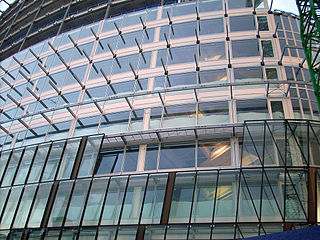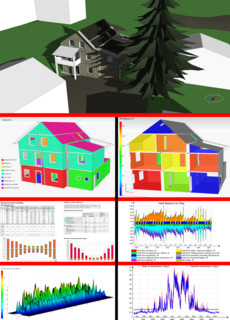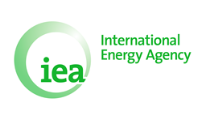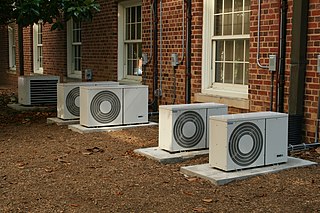Background
Substituting a heat pump to a boiler may save more than 50% of primary energy, if electricity is produced by a modern gas-steam power plant (and even more if a part of that electricity is produced from a renewable source). “Heat Pumping” is probably today one of the quickest and safest solutions to save energy and to reduce CO2 emission. Most of air-conditioned commercial buildings offer attractive retrofit opportunities, because:

A heat pump is a device that transfers heat energy from a source of heat to what is called a heat sink. Heat pumps move thermal energy in the opposite direction of spontaneous heat transfer, by absorbing heat from a cold space and releasing it to a warmer one. A heat pump uses a small amount of external power to accomplish the work of transferring energy from the heat source to the heat sink. The most common design of a heat pump involves four main components – a condenser, an expansion valve, an evaporator and a compressor. The heat transfer medium circulated through these components is called refrigerant.
- When a chiller is used, the condenser heat can cover (at least a part of) the heating demand;
- When a chiller is not (fully) used for cooling, it can be (at least partially) re-converted into heat pump.

A chiller is a machine that removes heat from a liquid via a vapor-compression or absorption refrigeration cycle. This liquid can then be circulated through a heat exchanger to cool equipment, or another process stream. As a necessary by-product, refrigeration creates waste heat that must be exhausted to ambience, or for greater efficiency, recovered for heating purposes.

In systems involving heat transfer, a condenser is a device or unit used to condense a substance from its gaseous to its liquid state, by cooling it. In so doing, the latent heat is given up by the substance and transferred to the surrounding environment. Condensers can be made according to numerous designs, and come in many sizes ranging from rather small (hand-held) to very large. For example, a refrigerator uses a condenser to get rid of heat extracted from the interior of the unit to the outside air. Condensers are used in air conditioning, industrial chemical processes such as distillation, steam power plants and other heat-exchange systems. Use of cooling water or surrounding air as the coolant is common in many condensers.
The retrofit of an existing building and, even more, the design of a new one should take all possibilities of heat pumping into consideration, in such a way to make air conditioning as “reversible” as possible. Different techniques are already available, but a recent survey of monitoring results established in Germany made still appear a lot of faults, lacks of optimisation and surprisingly low COP (coefficient of performance) after, at least, one year of operation. It appears that the many mistakes would not have been discovered without monitoring. It also appears that these mistakes and disappointing results are mainly due to a lack of good understanding of the dynamic behaviour of the systems at design stage, a lack of simulation work, a lack of instrumentation, for satisfactory commissioning, optimal control and fault detection.

Germany, officially the Federal Republic of Germany, is a country in Central and Western Europe, lying between the Baltic and North Seas to the north, and the Alps to the south. It borders Denmark to the north, Poland and the Czech Republic to the east, Austria and Switzerland to the south, France to the southwest, and Luxembourg, Belgium and the Netherlands to the west.
The coefficient of performance or COP of a heat pump, refrigerator or air conditioning system is a ratio of useful heating or cooling provided to work required. Higher COPs equate to lower operating costs. The COP usually exceeds 1, especially in heat pumps, because, instead of just converting work to heat, it pumps additional heat from a heat source to where the heat is required. For complete systems, COP calculations should include energy consumption of all power consuming auxiliaries. COP is highly dependent on operating conditions, especially absolute temperature and relative temperature between sink and system, and is often graphed or averaged against expected conditions.

Heating, ventilation, and air conditioning (HVAC) is the technology of indoor and vehicular environmental comfort. Its goal is to provide thermal comfort and acceptable indoor air quality. HVAC system design is a subdiscipline of mechanical engineering, based on the principles of thermodynamics, fluid mechanics and heat transfer. "Refrigeration" is sometimes added to the field's abbreviation, as HVAC&R or HVACR or "ventilation" is dropped, as in HACR.

Building automation is the automatic centralized control of a building's heating, ventilation and air conditioning, lighting and other systems through a building management system or building automation system (BAS). The objectives of building automation are improved occupant comfort, efficient operation of building systems, reduction in energy consumption and operating costs, and improved life cycle of utilities.

Superinsulation is an approach to building design, construction, and retrofitting that dramatically reduces heat loss by using much higher levels of insulation and airtightness than normal. Superinsulation is one of the ancestors of the passive house approach.

A zero-energy building, also known as a zero net energy (ZNE) building, net-zero energy building (NZEB), net zero building or zero-carbon building is a building with zero net energy consumption, meaning the total amount of energy used by the building on an annual basis is roughly equal to the amount of renewable energy created on the site, or in other definitions by renewable energy sources elsewhere. These buildings consequently contribute less overall greenhouse gas to the atmosphere than similar non-ZNE buildings. They do at times consume non-renewable energy and produce greenhouse gases, but at other times reduce energy consumption and greenhouse gas production elsewhere by the same amount. A similar concept approved and implemented by the European Union and other agreeing countries is nearly Zero Energy Building (nZEB), with the goal of having all buildings in the region under nZEB standards by 2020.
Underfloor heating and cooling is a form of central heating and cooling which achieves indoor climate control for thermal comfort using conduction, radiation and convection. The terms radiant heating and radiant cooling are commonly used to describe this approach because radiation is responsible for a significant portion of the resulting thermal comfort but this usage is technically correct only when radiation composes more than 50% of the heat exchange between the floor and the rest of the space.
Solar air conditioning refers to any air conditioning (cooling) system that uses solar power.
An air source heat pump (ASHP) is a system which transfers heat from outside to inside a building, or vice versa. Under the principles of vapor compression refrigeration, an ASHP uses a refrigerant system involving a compressor and a condenser to absorb heat at one place and release it at another. They can be used as a space heater or cooler, and are sometimes called "reverse-cycle air conditioners".
The Energy Conservation Building Code (ECBC), was launched by Ministry of Power, Government of India in May 2007, as a first step towards promoting energy efficiency in the building sector.
Free cooling is an economical method of using low external air temperatures to assist in chilling water, which can then be used for industrial processes, or air conditioning systems. The chilled water can either be used immediately or be stored for the short- or long-term. When outdoor temperatures are lower relative to indoor temperatures, this system utilizes the cool outdoor air as a free cooling source. In this manner, the system replaces the chiller in traditional air conditioning systems while achieving the same cooling result. Such systems can be made for single buildings or district cooling networks.

The double-skin facade is a system of building consisting of two skins, or facades, placed in such a way that air flows in the intermediate cavity. The ventilation of the cavity can be natural, fan supported or mechanical. Apart from the type of the ventilation inside the cavity, the origin and destination of the air can differ depending mostly on climatic conditions, the use, the location, the occupational hours of the building and the HVAC strategy.
A Deep energy retrofit can be broadly categorized as an energy conservation measure in an existing building also leading to an overall improvement in the building performance. While there is no exact definition for a deep energy retrofit, it can be defined as a whole-building analysis and construction process that aims at achieving on-site energy use minimization in a building by 50% or more compared to the compared to the baseline energy use making use of existing technologies, materials and construction practices. Such a retrofit reaps multifold benefits beyond energy cost savings, unlike conventional energy retrofit. It may also involve remodeling the building to achieve a harmony in energy, indoor air quality, durability, and thermal comfort. An integrated project delivery method is recommended for a deep energy retrofit project. An over-time approach in a deep energy retrofitting project provides a solution to the large upfront costs problem in all-at-once execution of the project.

The International Energy Agency Solar Heating and Cooling Programme is one of over 40 multilateral Technology Collaboration Programmes of the International Energy Agency. It was one of the first of such programmes, founded in 1977. Its current mission is to "advance international collaborative efforts for solar energy to reach the goal set in the vision of contributing 50% of the low temperature heating and cooling demand by 2030.". Its international solar collector statistics Solar Heat Worldwide serve as a reference document for governments, financial institutions, consulting firms and non-profit organizations.

Air Infiltration and Ventilation Centre (AIVC) is the International Energy Agency (IEA) information centre on energy efficient ventilation of buildings.

Building performance simulation (BPS) is the replication of aspects of building performance using a computer-based, mathematical model created on the basis of fundamental physical principles and sound engineering practice. The objective of building performance simulation is the quantification of aspects of building performance which are relevant to the design, construction, operation and control of buildings. Building performance simulation has various sub-domains; most prominent are thermal simulation, lighting simulation, acoustical simulation and air flow simulation. Most building performance simulation is based on the use of bespoke simulation software. Building performance simulation itself is a field within the wider realm of scientific computing.

venticool is an international platform formed in 2012 focusing on ventilative cooling issues, with the overall goal to "mobilize the ventilative cooling potential in terms of energy conservation, health, and comfort".
In December 2013, the International Energy Agency (IEA) Energy in Buildings and Communities Programme Executive Committee decided to launch the three-year working phase of the Annex 66 on Definition and Simulation of Occupant Behavior in Buildings::. Annex 66 was officially closed on June 21, 2018.

The International Energy Agency Energy in Buildings and Communities Programme, formerly known as the Energy in Buildings and Community Systems Programme (ECBCS), is one of the International Energy Agency’s Technology Collaboration Programmes (TCPs). The Programme "carries out research and development activities toward near-zero energy and carbon emissions in the built environment".
Ventilative cooling is the use of natural or mechanical ventilation to cool indoor spaces. The use of outside air reduces the cooling load and the energy consumption of these systems, while maintaining high quality indoor conditions. Ventilative cooling strategies are applied in a wide range of buildings and may even be critical to realize renovated or new high efficient buildings and zero-energy buildings (ZEBs). Ventilation is present in buildings mainly for air quality reasons. It can be used additionally to remove both excess heat gains, as well as increase the velocity of the air and thereby widen the thermal comfort range. Ventilative cooling is assessed by long-term evaluation indices .Ventilative cooling is dependent on the availability of appropriate external conditions and on the thermal physical characteristics of the building.















